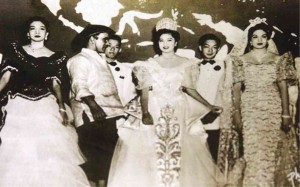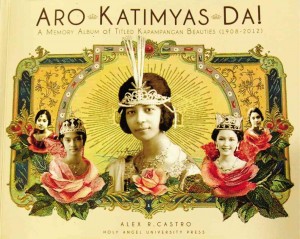When Ninoy was consort and little known facts on PH beauty contests

ESCORT A 21-year-old Benigno “Ninoy” Aquino Jr. (third from left) served as escort to his fellow Kapampangan, 1953 Miss Philippines Maria Cristina Galang (fourth from left). PHOTO REPRODUCTION AND PHOTO BY E.I. REYMOND T. OREJAS
Before he married Corazon “Cory” Cojuangco in 1954, Benigno “Ninoy” Aquino Jr., then in his early 20s, served as escort to Kapampangan beauty queen Maria Cristina Galang of Tarlac province.
Galang reigned as Miss Philippines during the Philippine International Fair in 1953.
A photograph showed Ninoy, then a bachelor, standing behind Galang as she was crowned. She bested rising movie stars, high-society girls and provincial delegates, including Imelda Romualdez, who would later become the country’s First Lady.
Galang, then 19 and a student at Lyceum, was a daughter of former Tarlac Gov. Alejandro Galang. Ninoy, a native of Concepcion, Tarlac, had been working as adviser of then Defense Secretary Ramon Magsaysay. At 17, he made a name for himself as the youngest correspondent to cover the Korean War for the Manila Times.
Ninoy was familiar with beauty contests because his mother, Aurora Aquino, of Concepcion town, was a Lakambini (Maid of Honor) in a 1927 petit fair, a local quest of the first nationwide beauty competition, the Manila Carnival, that began in 1908.
It was after his stint as Galang’s escort that Ninoy married Cory on Oct. 11, 1954, and was elected mayor of Concepcion at the age of 22 in 1955.
Art director Alex Castro dug this least-known fact about Ninoy and of the country’s beauty queens and pageants for his book, “Aro Katimyas Da! (How charming they are / A Memory Album of Titled Kapampangan Beauties (1908-2012).”
In the page for consorts of national beauty queens, Ninoy is joined by Dr. Basilio Valdez (for 1926 Carnival Queen Carmen Prieto) and Ernesto Santos (for 1938 Miss Philippines Guia Balmori).
Homesick
It was while working in the advertising agency D’Arcy Masius Benton & Bowles in Bangkok, Thailand, from 1991 to 1995 when Castro was struck by homesickness.
To cure this, he combed a flea market in 1994 for anything Filipino, finding old photographs of Manila Carnival queens. He never stopped collecting, acquiring 4,000 pictures of Filipino beauty queens since
Pura Villanueva of Iloilo won the 1908 Manila Carnival.
Old photographs of places, people and events in Pampanga province also inspired him to ask the Center for Kapampangan Studies (CKS) of Holy Angel University (HAU) to publish his first book, “Views from the Pampang” in 2006.
An “annotated pictorial history album” is how Castro calls his latest work, describing it to be a “tribute to my lovely kabalen (province mates).”
The book documented a comprehensive list of winners with known and traceable Kapampangan roots who have won official beauty titles.
Castro and the CKS launched the book on July 27 or a year before the 50th anniversary of the crowning of Gemma Cruz-Araneta as Miss International in 1964.
“We seem to add another bragging right: That our women are also among the loveliest in the country,” HAU president Arlyn Villanueva said at the launch.
The book, Villanueva said, was “not just about the physical beauty of our Kapampangan women, but about their spunk, their gentility, the strength of their character and the force of their convictions, which are all personified in the Kapampangan beauty title holders.”
“Our Kapampangan women are often described as solicitous to their husbands to the point of servitude, but our history is studded also with women who fought as revolutionaries, as Huk [members] and as New
People’s Army rebels,” Villanueva said.
Pageants
A fair that featured agricultural, commerce and industrial advancements in the provinces, called the Manila Carnival, which was mounted on and off in 31 years, pioneered beauty pageants in the country.
Universities and colleges fielded their students to the contest.
The Philippines Free Press held its search for Reina de la Belleza (beauty queen) by casting votes for contestants in photographs. The first to clinch the title was Amanda Hizon who married Chief Justice Jose Abad Santos.
A muse was selected for Rizal Day, which was declared by President Emilio Aguinaldo in 1898 in Malolos, Bulacan province. The one held in Manila by Club Filipino ended with Trinidad Ungson placing a crown of laurel on the head of the Rizal bust.
“The Americans transformed it into an affair with a carnival atmosphere, in the tradition of American National Heroes’ Day. Garden Day, also introduced by the Americans, selected Rizal Day muses,” Castro wrote.
Aguman or social clubs looked for their own muses. In the 1930s, beauty contests became fund-raising events for charities and antituberculosis campaigns.
The Weekly Women’s Magazine in 1953 began holding contests for Mrs. Philippines. Estrella Ocampo Lopez of San Fernando, Pampanga, won the crown that year.
Uproar
Multinational firms Procter & Gamble and Unilever held pageants to promote products. There were searches for Ms Vicks, Ms Camay, Ms Ever Girl, Ms Magnolia, Ms Aviation, Ms Maid of Cotton and Baron Travel Girl.
The Manila Carnival, actually, began on an uproar. Castro wrote that Capt. George Langhorne in 1907 asked the Philippine Assembly for a P50,000 funding to build a hall and “exhibit half-naked Igorots and set up amusements.”
Local newspapers protested, citing the outcome of the 1904 St. Louis exposition on Philippine tribes.
Castro said Governor General James Smith instead directed the secretary of commerce, William Cameron Forbes, to take over. Forbes “designed an international exposition to showcase Philippine-American progress,” Castro said.
Money was raised through sponsorship and public balloting for the queen of the carnival, which was held at the old Wallace Field in Luneta, Manila.
Women vying to be the carnival’s queen were required to have “a good standing in la alta sociedad, with impeccable breeding, character, education and personality, not to mention financial capability.”
The first queen, Pura Villanueva, was among the moving forces in the campaign to allow Filipino women to vote, which was granted in 1937.
Miss Philippines
It was in 1926 that the National Beauty Contest was held side by side the Manila Carnival, with the winner of the former called Miss Philippines.
The first Kapampangan Carnival Queen was Socorro Henson in 1926. The last Kapampangan titleholder was Guia Balmori in 1938.
“In the end, the Carnival was nothing more than a superficial attempt to divert the Filipinos from the real issues that plagued American colonial governance, a balm intended to soothe our wounded national pride,” Castro said.
Still, he said, the carnivals “were still the perfect showcases of the accomplishments of Pampanga’s daughters.”















